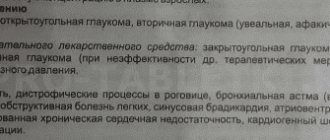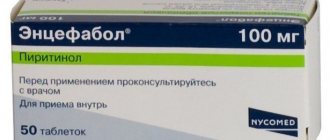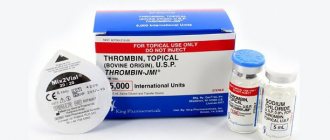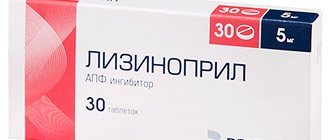pharmachologic effect
Anticoagulant. Direct thrombin inhibitor. Dabigatran etexilate is a low molecular weight prodrug that does not have pharmacological activity. After oral administration, it is rapidly absorbed and is converted into dabigatran by hydrolysis catalyzed by esterases.
Dabigatran is an active, competitive, reversible direct thrombin inhibitor and acts primarily in plasma.
Since thrombin (serine protease) converts fibrinogen into fibrin during the coagulation cascade, inhibition of its activity prevents the formation of a blood clot. Dabigatran inhibits free thrombin, fibrin-binding thrombin, and thrombin-mediated platelet aggregation.
In vivo and ex vivo animal studies using various thrombosis models have demonstrated the antithrombotic efficacy and anticoagulant activity of dabigatran after intravenous administration and dabigatran etexilate after oral administration.
A close correlation was found between the plasma concentration of dabigatran and the severity of the anticoagulant effect. Dabigatran prolongs the activated partial thromboplastin time (aPTT).
Pharmacokinetics
Suction
After taking the drug, the pharmacokinetic profile of dabigatran in the blood plasma of healthy volunteers is characterized by a rapid increase in plasma concentration with Cmax achieved within 0.5-2 hours.
After reaching Cmax, plasma concentrations of dabigatran decrease biexponentially, the final T1/2 averages about 14-17 hours in young people and 12-14 hours in elderly people. T1/2 does not depend on dose. Cmax and AUC vary proportionally to the dose. Food does not affect the bioavailability of dabigatran etexilate, but Tmax is delayed by 2 hours.
The absolute bioavailability of dabigatran is about 6.5%.
A study examining the absorption of dabigatran etexilate 1-3 hours after surgery demonstrated a slower absorption compared to healthy volunteers. A smooth increase in AUC without the appearance of Cmax in plasma was revealed. Cmax was observed at 6 hours after administration or at 7-9 hours after surgery. It should be noted that factors such as anesthesia, gastrointestinal paralysis and surgery may play a role in slowing absorption, regardless of the dosage form of the drug. Another study showed that slow absorption or delayed absorption is usually observed only on the day of surgery. In the following days, absorption of dabigatran occurs rapidly, reaching Cmax 2 hours after administration.
Distribution
A low ability (34-35%) of binding of dabigatran to human plasma proteins has been established, regardless of the concentration of the drug. The Vd of dabigatran is 60-70 L and exceeds the volume of total body water, indicating a moderate distribution of dabigatran in tissues.
Metabolism and excretion
After oral administration of dabigatran etexilate is quickly and completely converted to dabigatran, which is the active form in plasma. The main route of metabolism of dabigatran etexilate is hydrolysis catalyzed by esterases, which converts it to the active metabolite dabigatran.
When dabigatran is conjugated, 4 isomers of pharmacologically active acyl glucuronides are formed: 1-O, 2-O, 3-O, 4-O, each of which constitutes less than 10% of the total dabigatran content in plasma. Traces of other metabolites were detected only using highly sensitive analytical methods.
The metabolism and elimination of dabigatran were studied in healthy volunteers (men) after a single intravenous administration of radiolabeled dabigatran. The drug was excreted mainly through the kidneys (85%) unchanged. Excretion in feces was about 6% of the administered dose. Within 168 hours after administration of the drug, the removal of total radioactivity was 88-94% of the dose used.
Pharmacokinetics in special clinical situations
In volunteers with moderate renal impairment (creatinine clearance 30-50 ml/min), the AUC value of dabigatran after oral administration was 2.7 times higher compared to subjects with normal renal function. In severe renal failure (creatinine clearance 10-30 ml/min), the AUC value of dabigatran and T1/2 increased by 6 and 2 times, respectively, compared with patients without renal failure.
Compared with young people, in elderly patients the AUC and Cmax values increased by 40-60% and 25%, respectively. In population pharmacokinetic studies involving elderly patients up to 88 years of age, it was found that with repeated doses of dabigatran its content in the body increased. The observed changes correlated with an age-related decrease in creatinine clearance.
In 12 patients with moderate hepatic impairment (Child-Pugh class B), there were no changes in dabigatran levels compared to controls.
Population pharmacokinetic studies assessed pharmacokinetic parameters in patients weighing 48 to 120 kg. Body weight had little effect on plasma clearance of dabigatran. Its content in the body was higher in patients with low body weight. In patients weighing more than 120 kg, there was a decrease in the effectiveness of the drug by approximately 20%, and with a body weight of 48 kg, an increase of approximately 25% compared to patients with average body weight.
Phase 3 clinical studies showed no differences in the efficacy and safety of Pradaxa ® in men and women. In women, exposure to the drug was 40-50% higher than in men, but no dose adjustment was required.
A comparative study of the pharmacokinetics of dabigatran in Europeans and Japanese after a single and repeated dose of the drug in the studied ethnic groups did not reveal clinically significant changes. Pharmacokinetic studies have not been conducted in blacks.
Release form and composition
Pradaxa is produced in the form of capsules: oblong, opaque, with a cream-colored body with a black inscription (depending on the dose) “R 75”, “R 110” or “R 150” and a light blue cap with the symbol of the manufacturer (Boehringer Ingelheim ); the capsules contain yellowish pellets (10 pcs. in blisters, 1, 3 or 6 blisters in a cardboard pack; 60 pcs. in polypropylene bottles, 1 bottle in a cardboard pack).
Composition of 1 capsule:
- Active substance: dabigatran etexilate – 75, 110 or 150 mg (dabigatran etexilate mesylate – 86.48/126.83/172.95 mg);
- Auxiliary components (75/110/150 mg): acacia gum – 4.43/6.5/8.86 mg, coarse tartaric acid – 22.14/32.48/44.28 mg, tartaric acid powder – 29, 52/43.3/59.05 mg, crystalline tartaric acid – 36.9/54.12/73.81 mg, hypromellose – 2.23/3.27/4.46 mg, dimethicone – 0.04/0 .06/0.08 mg, talc – 17.16/25.16/34.31 mg, hydroxypropylcellulose (hyprolose) – 17.3/25.3734.59 mg;
- Capsule shell (75/110/150 mg): hypromellose capsule (HPMC) – 60/70/90 mg;
- HPMC capsules (75/110/150 mg): carrageenan (E407) – 0.2/0.22/0.285 mg, potassium chloride – 0.27/0.31/0.4 mg, titanium dioxide (E171) – 3 .6/4.2/5.4 mg, indigo carmine (E132) – 0.036/0.042/0.054 mg, sunset yellow dye (E110) – 0.002/0.003/0.004 mg, hydroxypropyl methylcellulose (hypromellose) – 52.9/61, 71/79.35 mg, purified water – 3/3.5/4.5 mg;
- Black ink (%, wt.): potassium hydroxide – 0.5-0.1%, shellac – 24-27%, butanol – 1-3%, isopropanol – 1-3%, propylene glycol – 3-7%, ethanol – 23-26%, aqueous ammonia – 1-2%, black iron oxide dye (E172) – 24-28%, purified water – 15-18%.
Dosage regimen
The drug is prescribed orally.
For adults
for
the prevention of venous thromboembolism (VT)
in patients after orthopedic surgery, the recommended dose is 220 mg/day. once (2 capsules of 110 mg).
In patients with moderate renal impairment
increased risk of bleeding, the recommended dose is 150 mg/day. once (2 capsules of 75 mg).
For the prevention of VT after knee replacement
treatment should begin 1-4 hours after completion of the operation with a dose of 110 mg, followed by an increase in the dose to 220 mg/day. once over the next 10 days. If hemostasis is not achieved, treatment should be delayed. If treatment has not started on the day of surgery, therapy should begin with a dose of 220 mg/day. once.
For the prevention of VT after hip replacement
treatment should begin 1-4 hours after completion of the operation with a dose of 110 mg, followed by an increase in the dose to 220 mg/day. once over the next 28-35 days. If hemostasis is not achieved, treatment should be delayed. If treatment has not started on the day of surgery, therapy should begin with a dose of 220 mg/day. once.
Patients with severe hepatic impairment (Child-Pugh class B and C) or with
liver
that could affect survival, or with an increase of more than 2 times the ULN of liver enzymes were excluded from clinical studies. In this regard, the use of Pradaxa in this category of patients is not recommended.
After intravenous administration, 85% of dabigatran is excreted through the kidneys. In patients with moderate renal impairment (creatinine clearance 30-50 ml/min)
there is a high risk of bleeding. In such patients, the dose should be reduced to 150 mg/day.
Creatinine clearance is determined using the Cockcroft formula:
For men
CC (ml/min)=(140-age) X body weight (kg)/72 x serum creatinine (mg/dL)
For women
0.85 x CC value for men.
There is no data on the use of the drug in patients with severe renal impairment (creatinine clearance less than 30 ml/min).
The use of
Pradaxa ® in this category of patients is not recommended.
Dabigatran is eliminated by dialysis
. No clinical studies have been conducted in such patients.
Experience of use in elderly patients over 75 years of age
limited. The recommended dose is 150 mg/day. once. When conducting pharmacokinetic studies in elderly patients who experience a decrease in kidney function with age, an increase in the content of the drug in the body was found. The dose of the drug should be calculated in the same way as for patients with impaired renal function.
Transition from treatment with dabigatran etexilate to parenteral anticoagulants
should be carried out 24 hours after the last dose of Pradaxa.
Switching from parenteral anticoagulants to Pradaxa:
There are no data, so it is not recommended to start therapy with Pradaxa before the planned administration of the next dose of a parenteral anticoagulant.
Rules for using the drug
1. Remove the capsules from the blister, peeling off the foil.
2.Do not squeeze capsules through the foil.
3.Remove the foil so much that it is convenient to remove the capsules.
Capsules should be washed down with water and taken with meals or on an empty stomach.
Pradaxa price
The cost of packaging capsules with instructions for use depends on the dosage, the specific retail outlet and other factors . Below is a table with prices for Pradaxa in Moscow:
| Pharmacy name | Dosage | Number of tablets | Price in rubles |
| "Zhivika" | 110 mg | 30 | 1595 |
| 60 | 2900 | ||
| 180 | 7555 | ||
| "E Pharmacy" | 75 mg | 30 | 1900 |
| 150 mg | 30 | 1685 | |
| 150 mg | 180 | 7700 | |
| "Ozerki" | 110 mg | 30 | 1630 |
| 60 | 3005 | ||
| 150 mg | 60 | 3155 | |
| 75 mg | 30 | 1715 |
Side effect
In controlled studies, some patients received the drug at 150-220 mg/day, some - less than 150 mg/day, and some - more than 220 mg/day.
Possible
bleeding of any location. Extensive bleeding is rare. The development of adverse reactions was similar to reactions in the case of enoxaparin sodium.
From the hematopoietic system:
anemia, thrombocytopenia.
From the blood coagulation system:
hematoma, wound bleeding, nosebleeds, gastrointestinal bleeding, rectal bleeding, hemorrhoidal bleeding, cutaneous hemorrhagic syndrome, hemarthrosis, hematuria.
From the digestive system:
liver dysfunction, increased activity of liver transaminases, hyperbilirubinemia.
From the laboratory parameters:
decrease in hemoglobin and hematocrit levels
Local reactions:
bleeding from the injection site, bleeding from the catheter insertion site.
Complications associated with procedures and surgical interventions:
bloody discharge from a wound, hematoma after procedures, bleeding after procedures, postoperative anemia, post-traumatic hematoma, bloody discharge after procedures, bleeding from the incision site, drainage after a procedure, wound drainage.
The frequency of observed adverse reactions when taking dabigatran etexilate did not exceed the frequency range of adverse reactions developing when using enoxaparin sodium.
Contraindications to the use of PRADAXA®
— severe renal failure (creatinine clearance less than 30 ml/min);
- hemorrhagic disorders, hemorrhagic diathesis, spontaneous or pharmacologically induced disorder of hemostasis;
- active clinically significant bleeding;
- liver dysfunction and liver disease that may affect survival;
- simultaneous use of quinidine;
- organ damage as a result of clinically significant bleeding, including hemorrhagic stroke during the previous 6 months before the start of therapy;
— age less than 18 years;
- known hypersensitivity to dabigatran or dabigatran etexilate or to one of the excipients.
Use of PRADAXA® during pregnancy and lactation
In experimental studies
Reproductive toxicity has been demonstrated in animals. There are no clinical data on the use of dabigatran etexilate during pregnancy. The potential risk to humans is unknown.
Women of reproductive age
Pregnancy should be avoided while being treated with Pradaxa. During pregnancy, the use of dabigatran etexilate is not recommended, unless the expected benefit outweighs the possible risk.
If dabigatran etexilate is used, breastfeeding should be discontinued. There are no clinical data on the use of the drug during breastfeeding.
Use for renal impairment
After intravenous administration, 85% of dabigatran is excreted through the kidneys. In patients with moderate renal impairment (creatinine clearance 30-50 ml/min) there is a high risk of bleeding. In such patients, the dose should be reduced to 150 mg/day.
Creatinine clearance is determined using the Cockcroft formula:
For men
CC (ml/min)=(140-age) X body weight (kg)/72 x serum creatinine (mg/dL)
For women
0.85 x CC value for men.
There is no data on the use of the drug in patients with severe renal impairment (creatinine clearance less than 30 ml/min).
The use of
Pradaxa ® in this category of patients is not recommended.
Dabigatran is eliminated by dialysis
. No clinical studies have been conducted in such patients.
Compound
tablets of 0.25 No. 100 • wheat germ flour; • seaweed; • parsley; • cardamom; • pine nut kernel; • quercetin; • coriander; • essential oils; • cellulose; • phospholipids; • proteolytic enzymes; • carotenoids; • amino acids; • tocopherols. Chemical composition: protein - 20%, lipids - 6%, carbohydrates - 15%, dietary fiber - 30%, minerals - 20%. Mineral content: calcium -1000 mg%, magnesium - 300 mg%, phosphorus -500 mg%, potassium -200 mg%, iodine -250 mg%, iron -100 mg%, zinc -30 mg%, copper - 10 mg %, alginic acid - up to 15%, beckons - up to 10%. Vitamin content: C-200 mg%, B1 -2-4 µg%, B2- 15 mg%, B3-40 mg%, B6 - 20 mg%, B12 - 40 µg%.
special instructions
Unfractionated heparin can be used to preserve the functioning of a central venous or arterial catheter.
Unfractionated heparins or their derivatives, low molecular weight heparins, fondaparinux sodium, desirudin, thrombolytic agents, GPIIb/IIIa receptor antagonists, clopidogrel, ticlopidine, dextran, sulfinpyrazone and vitamin K antagonists should not be used simultaneously with Pradaxa
The combined use of Pradaxa in doses recommended for the treatment of deep vein thrombosis and acetylsalicylic acid in doses of 75-320 mg increases the risk of bleeding. There are no data demonstrating an increased risk of bleeding associated with dabigatran when taking Pradaxa at the recommended dose in patients receiving low doses of acetylsalicylic acid for the prevention of cardiovascular disease. However, the available information is limited, therefore, when using low-dose acetylsalicylic acid and Pradaxa together, it is necessary to monitor the condition of patients in order to timely diagnose bleeding.
Careful monitoring (for symptoms of bleeding or anemia) should be carried out in cases in which there may be an increased risk of developing hemorrhagic complications:
- recent biopsy or trauma;
- use of drugs that increase the risk of developing hemorrhagic complications;
- a combination of Pradaxa with drugs that affect hemostasis or coagulation processes;
- bacterial endocarditis.
Prescription of NSAIDs for a short time when combined with Pradaxa with an analgesic chain after surgery does not increase the risk of bleeding. There is limited data regarding the systematic use of NSAIDs with T1/2 less than 12 hours in combination with Pradaxa, there is no evidence of an increased risk of bleeding.
Pharmacokinetic studies have shown that in patients with decreased renal function, incl. associated with age, there was an increase in the effectiveness of the drug. In patients with moderately reduced renal function (creatinine clearance 30-50 ml/min), it is recommended to reduce the daily dose to 150 mg/day. Pradaxa is contraindicated in patients with severe renal impairment (creatinine clearance <30 ml/min). If acute renal failure develops, the drug should be discontinued.
In the case of traumatic or repeated spinal puncture and prolonged use of an epidural catheter, the risk of developing spinal bleeding or epidural hematoma may increase. The first dose of Pradaxa should be taken no earlier than 2 hours after removal of the catheter. Such patients should be monitored for possible detection of neurological symptoms.
Impact on the ability to drive vehicles and operate machinery
The effect of dabigatran etexilate on the ability to drive vehicles and operate machinery has not been studied.
The use of dabigatran in real clinical practice and the risk of bleeding
Atrial fibrillation (AF) is associated with an increased risk of stroke and death. The use of vitamin K antagonists, in particular warfarin , led to a reduced risk of stroke and death, but increased the risk of bleeding compared with the use of comparators [1]. The use of warfarin is recommended in patients with AF and risk of stroke [2]. However, warfarin therapy is associated with certain difficulties due to multiple interactions with foods and drugs; In addition, this therapy requires frequent laboratory tests. For these reasons, drugs in this class are often not used, and if they are, the discontinuation rate is very high [3, 4]. In many patients using warfarin, the effectiveness of anticoagulant therapy remains insufficient [5]. Thus, there is a need to use new anticoagulants that are effective, safe and easy to use.
RE-LY Study Data
Let us briefly recall that during the RE-LY study (Randomized Evaluation of Long-Term Anticoagulation Therapy), the use of dabigatran (direct thrombin inhibitor) 110 mg compared with warfarin was accompanied by a similar incidence of stroke and thromboembolism in the vessels of the systemic circulation and less high incidence of severe bleeding. The use of dabigatran 150 mg compared with warfarin was associated with a lower incidence of stroke, but a similar incidence of severe bleeding. The rates of major bleeding in the warfarin dabigatran 110 mg group (for comparison of dabigatran 110 mg group and warfarin group RR=0.80 with 95% CI from 0.69 to 0.93; p=0.003; for comparison of dabigatran 150 mg group with warfarin group RR=0.93 with 95 % CI 0.81 to 1.07; p=0.31). The incidence of life-threatening bleeding, intracranial hemorrhage, severe or mild bleeding was higher in the warfarin group (1.80, 0.74 and 18.5%, respectively) compared with that in the dabigatran 110 mg group (1.22; 0.23 and 14.62%, respectively; p
Side effects of dabigatran
On January 12, 2012, the attention of doctors around the world was attracted by a publication in the journal QuarterWatch [6], the publication of the non-profit organization Institute for Safe Medical Practices , whose activities are dedicated to “preventing errors in medical practice and ensuring the safety of drug use.” The article stated that after the introduction of dabigatran for the prevention of stroke in patients with atrial fibrillation in October 2010, there were many reports of side effects. Thus, in the first quarter of 2011 alone, 932 side effects were reported that were associated with taking the drug, including 120 cases of death, 25 cases of permanent disability and 543 cases of side effects that required hospitalization. Of the 932 cases of side effects while taking dabigatran, 505 cases were bleeding, which was much higher than the number of reported cases of bleeding while taking warfarin, which was only 176 cases. At the same time, special attention was paid to the report of 120 cases of hemorrhagic stroke .
It should be noted that side effects of dabigatran associated with bleeding developed predominantly in older people (median age 80 years), compared with patients who developed bleeding while taking other drugs (median age 56 years). Approximately 25% of patients who developed bleeding while using dabigatran were 84 years of age or older, which raises doubts about the safety of the doses of dabigatran used in elderly and senile patients. Let us recall that, unlike warfarin, dabigatran in the United States has a single dose of 150 mg 2 times a day (except for patients with severe renal failure ).
Use of dabigatran in patients with reduced renal excretory function
Impaired renal function may be a factor that, at least in part, explains the increased risk of bleeding with dabigatran use in real life. During clinical trials of dabigatran, it was noted that even with mild renal impairment, the concentration of dabigatran in the blood is 50% higher than in patients with normal renal function, and with a moderate deterioration in renal function, the concentration of dabigatran in the blood can increase 3 times. At the same time, the instructions for use of dabigatran recommend reducing the dose of the drug only in cases of severe renal impairment: only in such cases the dose of dabigatran should be 75 mg 2 times a day. At the same time, according to experts, it is unknown whether taking dabigatran 75 mg 2 times a day will be effective in reducing the risk of stroke. It should be noted, however, that in Russia and some other countries the approved dose of dabigatran is 110 mg 2 times a day. It is likely that this dose will be safer in patients over 70 years of age.
Risk of complications when switching patients from warfarin to dabigatran
In May 2012, reports again appeared confirming an increase in the risk of bleeding in real clinical practice when switching patients from taking warfarin to taking dabigatran . This conclusion was made based on the results of an observational study carried out in real practice in the treatment of patients with AF [7]. The study identified 113 patients who were switched from warfarin to dabigatran. In such patients, the incidence of adverse outcomes was compared after taking the drug for 6 months. before switching to dabigatran with the frequency of such outcomes within 6 months. after starting dabigatran.
The duration of the period during which the international normalized ratio (INR) was in the therapeutic range (2.0 to 3.0) reached 70% of the total duration of warfarin treatment. While taking warfarin, only one adverse clinical outcome was recorded (incidence 0.88%), which required discontinuation of the drug: hospitalization due to high INR . At the same time, while taking dabigatran, there were 13 cases of adverse outcomes (frequency 11.5%). These outcomes included death from gastrointestinal (GI) bleeding, 4 cases of nonfatal bleeding (two GI, one rectus sheath, and one intracranial hemorrhage associated with trauma), 4 cases of deep vein thrombosis , 1 case of arterial thrombosis , 1 case of transient cerebrovascular accident , 1 case of skin rash and 4 cases of gastrointestinal symptoms.
It should be noted that such side effects were more often observed mainly in elderly patients and women. The average age of patients who developed complications associated with the use of dabigatran was 73.4 years, while the overall age of patients taking dabigatran was 66.5 years. If among all patients taking dabigatran, the proportion of women was 29%, then in the group of patients who developed bleeding while taking this drug, the proportion of women reached 71%.
Possible reasons for the high incidence of side effects
According to MW Wurster [7], the problems that arose with the use of dabigatran in real clinical practice were due to the fact that it was initially presented as a drug “that can be forgotten once prescribed.” Actually this is not true. The fact that INR monitoring is not required while taking dabigatran does not mean that monitoring of its use is not required. Patients taking dabigatran should be monitored quarterly to assess renal function, as well as concomitant medications and compliance with the prescribed treatment regimen.
dabigatran therapy regimen . Because newer anticoagulants have a short half-life, missing even one or two doses can have severe adverse effects. Perhaps the only advantage of warfarin is that it has a long half-life , so skipping a dose of this drug is usually not accompanied by adverse consequences. It should be recalled that approximately 40% of patients miss a dose of warfarin once a week or more often, even if they are treated under the supervision of staff at so-called anticoagulant clinics. However, newer anticoagulants have a much shorter half-life. According to MW Wurster, missing two or three doses of dabigatran can lead to blood clot formation within two days.
Frequency of complications in real clinical practice
It should be noted that after the release of a new drug on the pharmaceutical market, during the first few years there is increased attention to the side effects of its use in real clinical practice. The frequency of reports of side effects in such cases may differ from the actual frequency of complications due to systematic errors: including due to the influence of the new drug on the frequency of reports (the so-called Weber effect).
Important information about the actual incidence of bleeding can be obtained using data from the recently established GLORIA AF , which is expected to include 56,000 patients with new-onset AF living in 50 countries and will be followed up until 2021.
Recently, experts from the European Medicines Agency, based on a thorough analysis of the data, concluded that the use of dabigatran in general, after its use in real clinical practice, was accompanied by a significantly lower incidence of fatal bleeding compared with that during clinical trials [8] . However, experts from the Committee on the Use of Medicinal Products in Humans of the European Medicines Agency nevertheless recommend continued close monitoring of the risk of bleeding when using this anticoagulant. It was noted that case reports of bleeding often included patients with trauma or wounds. In this regard, the issue of the need to include in the information about the drug recommendations for immediate seeking medical help after a fall and injury in patients taking dabigatran .
Thus, although in general there is no doubt about the clinical benefits of taking dabigatran broadly in patients with AF , in any case, patients taking anticoagulants require more careful monitoring in real clinical practice due to the increased risk of bleeding.
Literature
- Hart RG, Pearce LA, Aguilar MI Meta-analysis: antithrombotic therapy to prevent stroke in patients who have nonvalvular atrial fibrillation. Ann Intern Med 2007;146:857–867.
- Fuster V., Rydén LE, Cannom DS, et al. ACC/AHA/ESC 2006 guidelines for the management of patients with atrial fibrillation — executive summary: a report of the American College of Cardiology/American Heart Association Task Force on Practice Guidelines and the European Society of Cardiology Committee for Practice Guidelines (Writing Committee to Revise the 2001 Guidelines for the Management of Patients with Arial Fibrillation). J Am Coll Cardiol 2006;48:854–906. [Erratum, J Am Coll Cardiol 2007;50:562.]
- Birman-Deych E., Radford MJ, Nilasena DS, Gage BF Use and effectiveness of warfarin in Medicare benefits with atrial fibrillation. Stroke 2006;37:1070–1074.
- Hylek EM, Evans-Molina C, Shea C, et al. Major hemorrhage and tolerance of warfarin in the first year of therapy among elderly patients with atrial fibrillation. Circulation 2007;115:2689–2696.
- Connolly SJ, Pogue J, Eikelboom J, et al. Benefit of oral anticoagulant over antiplatelet therapy in atrial fibrillation depends on the quality of international normalized ratio control achieved by centers and countries as measured by time in therapeutic range. Circulation 2008;118:2029–2037.
- Institute of Safe Medication Practices. ISMP Medication Safety Alert, January 12, 2012. Available at: https://www.ismp.org/Newsletters/
- Wurster MW Dabigatran use in the real world: Preliminary results of a prospective trial comparing outcomes with dabigatran and warfarin therapy. Proceedings of the Thrombosis and Hemostasis summit of North America: Research abstracts. Am J Hematol 2012; 87:S146–S200.
- European Medicines Agency. European Medicines Agency updates patient and prescriber information for Pradaxa. May 25, 2012. Available at: https://www.ema.europa.eu/.
Overdose
There is no antidote for dabigatran etexilate or dabigatran.
Using doses of the drug higher than recommended leads to an increased risk of bleeding. If bleeding develops, treatment should be suspended to determine the cause of the bleeding. Given the main route of elimination of dabigatran through the kidneys, it is recommended to ensure adequate diuresis. If necessary, surgical hemostasis or transfusion of fresh frozen plasma is possible.
Dabigatran is removed by dialysis, but clinical experience with this method is lacking.
Drug interactions
Concomitant use with drugs that affect hemostasis or coagulation processes, including vitamin K antagonists, can significantly increase the risk of bleeding.
Dabigatran etexilate and dabigatran are not metabolized by the cytochrome P450 system and do not affect cytochrome P450 enzymes in humans in vitro. Therefore, when used together with Pradaxa, drug interactions are not expected.
When used together with atorvastatin, no interaction is observed.
When used together, the pharmacokinetics of diclofenac and dabigatran etexilate do not change, indicating little interaction. Short-term use of NSAIDs to reduce pain after surgery did not increase the risk of bleeding.
There is limited experience with the use of Pradaxa in combination with long-term systematic use of NSAIDs, and therefore careful monitoring of the patient's condition is required.
No pharmacokinetic interaction with digoxin has been identified.
Clinical studies have not revealed the effect of the combination of pantoprazole or other proton pump inhibitors and Pradaxa on the development of bleeding or pharmacological effects.
When used together with ranitidine, the extent of absorption of dabigatran does not change.
When Pradaxa and amiodarone are used together, the rate and degree of absorption of the latter and the formation of its active metabolite desethylamiodarone do not change. AUC and Cmax increase by 60% and 50%, respectively. When using dabigatran etexilate and amiodarone together, it is necessary to reduce the dose of Pradaxa to 150 mg/day. Due to the long half-life of amiodarone, potential drug interactions may persist for several weeks after discontinuation of amiodarone.
Caution should be exercised when using Pradaxa together with active P-glycoprotein inhibitors (verapamil, clarithromycin).
Repeated administration of verapamil over several days increased dabigatran concentrations by 50-60%. This effect may be reduced if dabigatran is administered at least 2 hours before verapamil.
Concomitant use of Pradaxa with quinidine is contraindicated.
Potential inducers such as rifampicin and St. John's wort extract may reduce the effect of dabigatran. Caution should be exercised when using dabigatran with similar drugs.
When dabigatran is used concomitantly with antacids and gastric secretagogues, no change in the dose of dabigatran is required.
There was no interaction of dabigatran with opioid analgesics, diuretics, paracetamol, NSAIDs (including COX-2 inhibitors), HMC-CoA reductase inhibitors, cholesterol/triglyceride lowering drugs (not related to statins), angiotensin II receptor blockers , ACE inhibitors, beta-blockers, calcium channel blockers, prokinetics, benzodiazepine derivatives.
Analogues of Pradaxa
This product has virtually no analogues. But if necessary, you can replace the medicine with drugs similar in action. Below are well-known analogues of Pradaxa:
- Warfarin is a vitamin K antagonist, a drug that reduces blood clotting. The drug was synthesized more than 50 years ago, but it has been used relatively recently. For cardiac patients, the medicine is prescribed to reduce the risk of thrombosis and thromboembolism. The active substance is warfarin sodium. Price 100-170 rubles.
- Xarelto is a factor Xa inhibitor, a direct-acting anticoagulant. The medicine is produced on the basis of rivaroxaban and is characterized by rapid action and high bioavailability. After using the drug, the patient does not need to monitor coagulation parameters (blood clotting). The medicine has a small number of contraindications and combines well with other medicines. Price 1800-3500 rubles.
- Phenilin is a drug based on phenindione. The drug is an indirect anticoagulant that affects blood clotting. The use of the drug promotes the development of hypoprothrombinemia associated with impaired liver synthesis of prothrombin, reduces the formation of factors X, VII, IX. Phenilin has a significant cumulative effect. Price 110-130 rubles.










